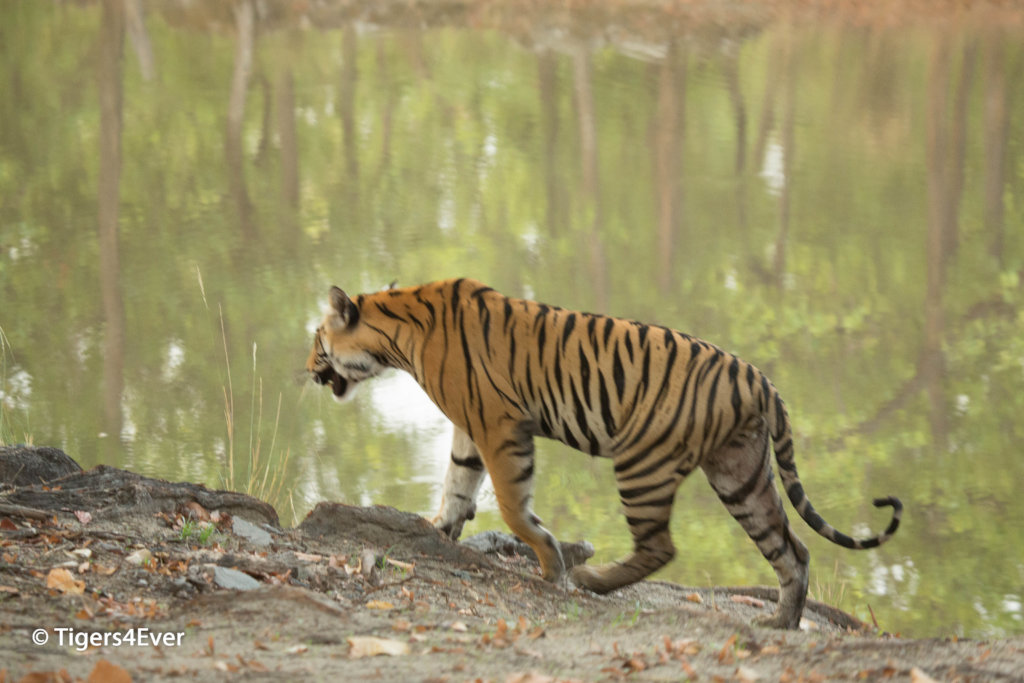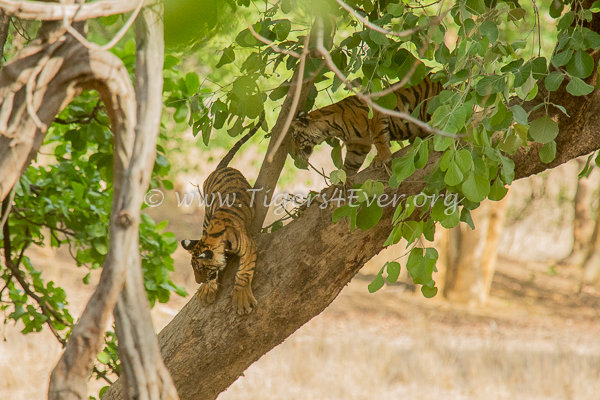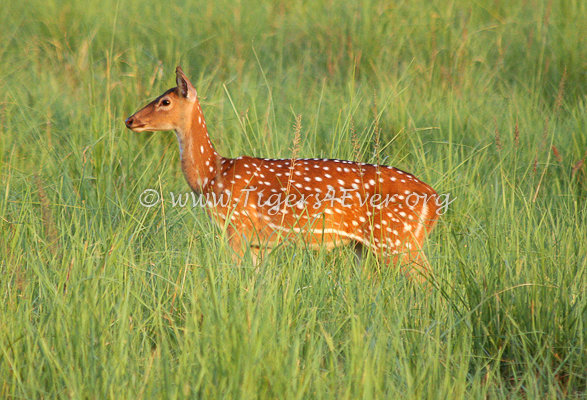By Dr. Corinne Taylor-Smith | Project Leader
The monsoon season is drawing to a close with thunderstorms and showers now a rare occurrence. Over the next few months tigers and the other wildlife which share their forest home will face much cooler drier conditions with early morning mists blanketing the lush greenery of the post monsoon forest. The early morning mists make it a little easier for wild tigers to sneak up and ambush their prey but it also means that life is a lot more for the anti-poaching patrollers who risk their lives to keep wild tigers safe.
Thanks to the donations we received from online and offline fundraising during the monsoon we were able to patrol at 83% of planned patrolling levels. A shortfall in fundraising meant that we had to reluctantly reduce our patrolling by 17% during peak poaching season. As always happens, during the heavy monsoon rains, there are casualties in the wild tiger, human and other wildlife populations. These deaths arise from a variety reasons including snake bites, old age, and drowning of weaker or infirm animals in the localised floods which result from the sudden surge and overflow of replenished rivers.
Sadly, we have to report the deaths of eight tigers during the 2019 monsoon period. The oldest tigress in Bandhavgarh was the first to die as her body weakened by old age and failing limbs (suspected arthritis) in July. A few days later we received news of three more tiger deaths as a tigress sought to defend her cubs from an intruding male lost her life in the fight and her male cub also died close by from the wounds inflicted by the male. The female cub was rescued by forest department officials who arranged immediate treatment by a vet and housed the cub in a specially designed enclosure to allow her time to recover. In a separate incident, a young sub-adult male tiger was bitten by a venomous snake and died a few hours later. Further bad news arrived just a few days later when the rescued female cub also died from the wounds inflicted by the intruding male. It had been a bad start to the monsoon period with five tiger deaths in a matter of weeks.
Things didn’t really improve as we moved into August with the discovery of another young cub abandoned by his mother and dead in the undergrowth. It was difficult for the patrollers to determine why his mother had left him behind, maybe he was unwell or maybe he was just weaker than his siblings and couldn’t keep up with them. As September arrived, and the heavy rains became more sporadic, we received reports that one of the older tigresses in Bandhavgarh hadn’t been seen by the patrolling teams for quite a few weeks, she had left her two cubs whilst she went off to hunt but hadn’t returned, not wishing to lose any more tigers the forest department decided to rescue the cubs and put them in an enclosure where could learn vital hunting skills by killing easier prey. The search for their mother continued and a few days later her skeleton was discovered in the think undergrowth, cleaned by the vultures, she had obviously died a few days or possibly a week earlier. The final reported tiger death came when we received news that a tigress had died near to a river which had burst its banks, she was a young tigress and is thought to have struggled to cross the river as a sudden swell caused a fierce current as she tried to cross.
It is always sad and difficult to receive and report so many tiger deaths in such a short period of time, the only consolation is that the deaths were not due to illicit poaching or poisoning activities.
Now we must prepare for the challenges presented by the cooler post monsoon weather, as summer turns to winter. Yes the weather is much drier in winter but it is much colder too. Our anti-poaching patrollers can put away their waterproof clothing for a while and turn to study warm boots and warm jackets to protect them from the early morning and night time cold. They also need to be extra vigilant in the early morning mist as visibility is reduced so spotting wild animals including tigers lurking in the undergrowth is more of a challenge. At this time of year, our patrollers are always grateful for the alarm calls sounded by the langur monkeys high in the trees, especially the panicked alarm call which alerts the monkey troop to the presence of a leopard on the move. Leopards present a greater risk to both humans and monkeys because they are much better at climbing trees, than tigers, when in pursuit of their prey.
Peak poaching season may be drawing to a close, but it doesn’t mean our patrollers can relax, quite the contrary in fact. During the monsoon rains the plants and grasses in the jungle have flourished but so have the crops in the villages too. Wildlife doesn’t distinguish between the jungle and human habitat so human-animal conflict often increases when the fields are filled with crops of rice, fruit, vegetables, sugar cane and other grain crops too. The herbivores often see these crops as food for them and indulge themselves at the farmers’ expense. This can lead to traps and snares being set around the villages to prevent crop raiding wildlife, but where the prey ventures the predators, including tigers, will follow. These traps and snares are both illegal and indiscriminate but it doesn’t prevent them being laid. Prior to the establishment of our anti-poaching patrols many tigers, young and old, fell victim to these snares and traps even though their purpose was to prevent wild boar and deer, etc., from raiding the crops. For this reason, we utilise local intelligence in our patrolling network to discover which villages and farms have been most affected by crop raiding, loss of livestock, etc., as these are the villagers who are most likely to take retaliatory action against the wildlife which they see as a nuisance. In the last few weeks, our patrollers have been mobilised to search around the perimeter of two villages where we had received information that snares and traps had been laid. Our patrollers were quick to ensure the removal of these traps and snares before any tigers or other wildlife fell victim.
It isn’t just about removing the traps and snares, it is also as important to communicate with the villagers about the consequences of such traps and snares for both the wildlife and themselves. Many are unaware of the consequences of their actions, so our patrollers talk to them about other ways to protect their crops and livestock, from their wild neighbours, without inflicting harm. It is, after all, the people who live with wild tigers on their doorstep who will have the greatest say as to whether wild tigers will have a wild future. For this reason, we have always had a community focus with all our wild tiger conservation projects: we recruit our anti-poaching patrollers (and other workers) from the local villages, use local suppliers to make their uniforms, equipment and the food which our patrollers eat whilst on duty. This way the villages are dependent on the wild tigers for income from other sources which sustain their wellbeing too. Providing a uniform and full equipment for one patroller cost just £123 ($165) but can provide employment for up to 20 people https://goto.gg/34704 plus the patroller, and that means that at least 21 people and their families need wild tigers to survive to ensure that their work will continue into the future. When we say that all donations can really make a big difference to saving wild tigers, no matter how large or small the donation is: https://goto.gg/34704, we hope that you can see why.
We want to end this newsletter on a positive note because it isn’t all bad news for the wild tiger numbers in Bandhavgarh. In the four and a quarter years since we established our first of its kind buffer zone anti-poaching patrols (established 01 July 2015) we have seen the number of wild tigers in Bandhavgarh double, we have eliminated wild tiger deaths from retaliatory poisoning and have seen a 96% reduction in wild tiger poaching, which gives us the confidence that our community focussed projects are getting it right. As we have said previously, we are eternally grateful for the bravery and ingenuity of the men and women who are the Tigers4Ever anti-poaching patrollers and who risk their lives each day to ensure that wild tigers are safe. As we don’t receive any grants or government funding, we are entirely dependent on the generosity of our supporters, people like you, to keep our patrols protecting wild tigers.
Thank you for sparing the time to read this newsletter and for all your amazing support and donations. We know that Christmas is on the horizon for many of you now, so it is always difficult to ask, however, wild tigers’ lives are at risk 24 hours a day 365 days a year so it is essential that our patrollers are there to keep them safe. If you can afford to help, please donate now at: https://goto.gg/34704 and help us to continue to give wild tigers a wild future, every little really does make a big difference.
Finally, as always, I would like to thank you on behalf of the wild tigers, which we are keeping safe; on behalf of the anti-poaching patrollers you are helping to keep in work (and their families who have food on the table). I would also like to thank you on behalf of the wider tiger community in Bandhavgarh, which benefits from providing food/uniforms/equipment for our patrols and from the safety/education advice given by Deepak, Prahlad, Vidya, Ravi and our patrolling team.
Links:
Project reports on GlobalGiving are posted directly to globalgiving.org by Project Leaders as they are completed, generally every 3-4 months. To protect the integrity of these documents, GlobalGiving does not alter them; therefore you may find some language or formatting issues.
If you donate to this project or have donated to this project, you can receive an email when this project posts a report. You can also subscribe for reports without donating.
Support this important cause by creating a personalized fundraising page.
Start a Fundraiser

